Summary
- Personal contact (22.6%), 80,000 Hours (13.5%), and a book, article, or blog post (13.1%) are the most common sources where respondents first hear about EA.
- 80,000 Hours, local or university EA groups, personal contacts, and podcasts have become more common as sources of where respondents first encounter EA.
- Facebook, Giving What We Can, LessWrong, Slate Star Codex / Astral Codex Ten, The Life You Can Save, and GiveWell have become less common.
- Respondents whose gender selection was ‘woman’, ‘non-binary’, or ‘prefer to self-describe’, were much more likely to have first heard of EA via a personal contact (30.2%) compared to respondents whose gender selection was ‘man’ (18.4%).
- 80,000 Hours (58.0%), personal contact with EAs (44.0%), and EA groups (36.8%) are the most common factors important for getting involved in EA.
- 80,000 Hours, EA Groups, and EAGx have been increasing in importance over the last years.
- EA Global, personal contact with EAs, and the online EA community saw a noticeable increase in importance for helping EAs get involved between 2020 and 2022.
- Personal contact with EAs, EA groups, the online EA community, EA Global, and EAGx stand out as being particularly important among highly engaged respondents for getting involved.
- Respondents who identified as non-white, as well as women, non-binary, and respondents who preferred to self-describe, were generally more likely to select factors involving social contact with EAs (e.g., EA group, EAGx) as important.
Where do people first hear about EA?
Personal contacts continue to be the most common place where people first hear about EA (22.6%), followed by 80,000 Hours (13.5%) and a book, article, or blog post (13.1%).[1]

Comparison across all years
The plot below shows changes in where people report first hearing of EA across time (since we ran the first EA Survey in 2014).[2]
We generally observe that the following routes into EA have been increasing in importance over time:
- 80,000 Hours
- Local or university EA groups
- Personal contacts
- Podcasts
And the following sources have been decreasing in importance:
- Giving What We Can
- LessWrong
- Slate Star Codex / Astral Codex Ten
- The Life You Can Save
- GiveWell
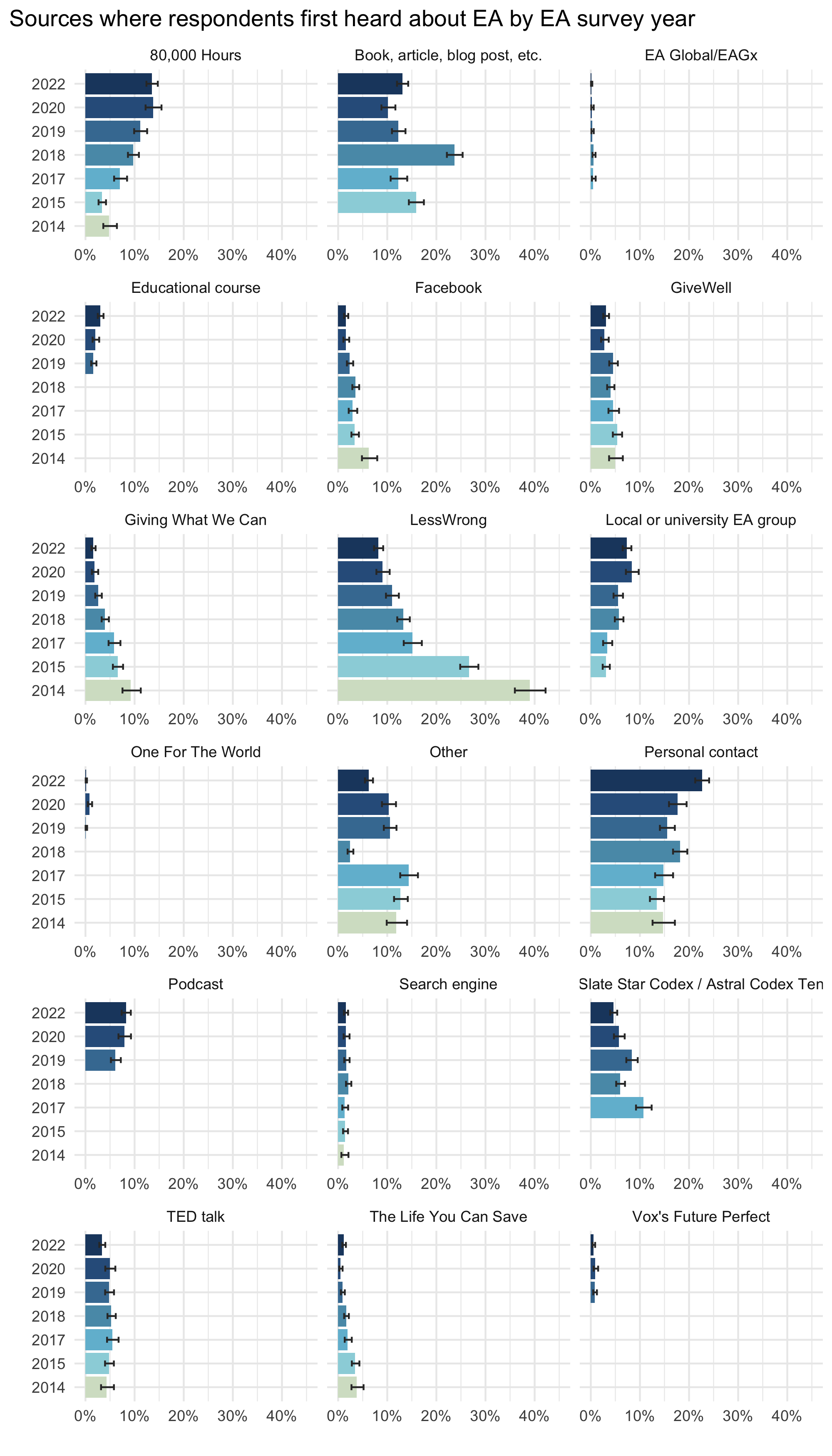
Comparison across cohorts
Several of the patterns observed in the previous section are also observed when we look at where different cohorts of EA respondents first encountered EA.[3] We see that more recent cohorts are more likely to have encountered EA via 80,000 Hours and podcasts, and are less likely to have encountered EA via Giving What We Can, LessWrong, and GiveWell. No clear cohort effects were observed for other sources. Note that the figure below omits categories with few observations (e.g., EA Global, EAGx).
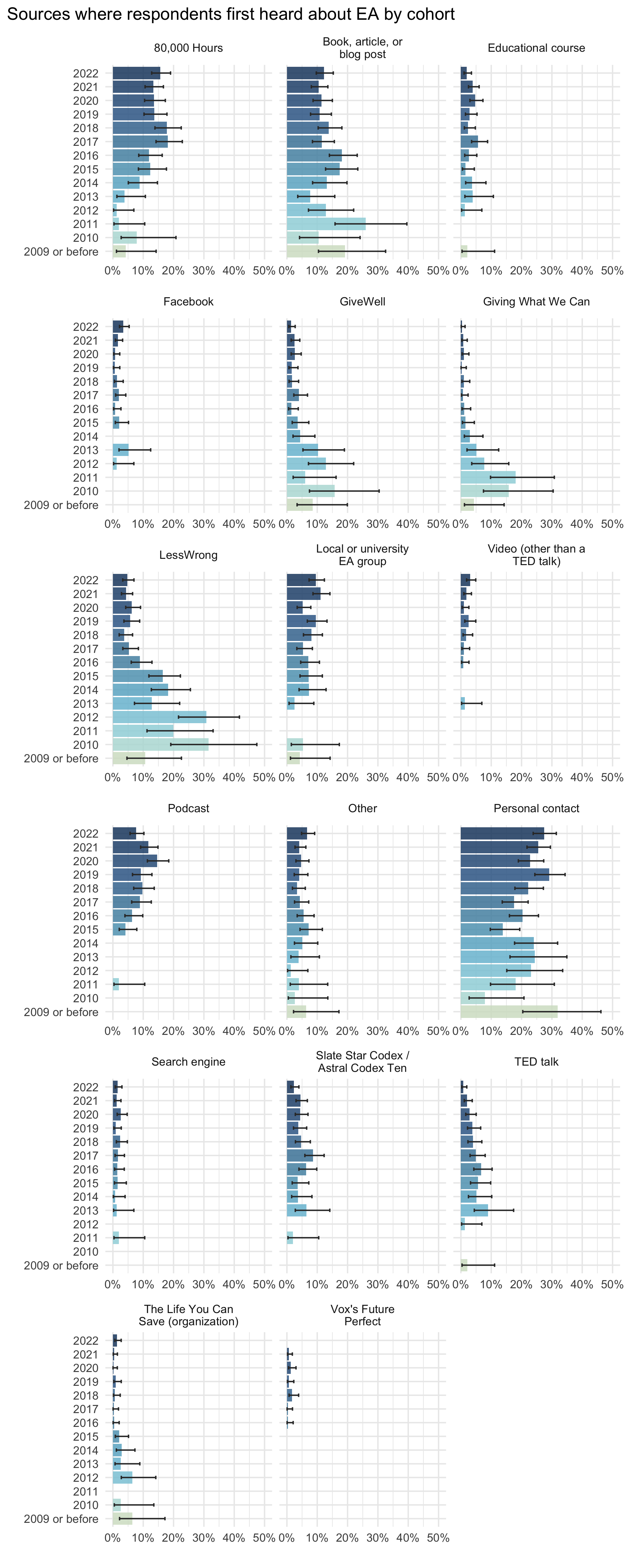
Further Details
We asked respondents to provide further details about their responses, and provide a breakdown for some of the larger categories. Details of other categories are available on request.
80,000 Hours
The largest number of respondents who first heard of EA through 80,000 Hours reported doing so through an independent search, e.g., they were searching online for “ethical careers” and found 80,000 Hours. The second largest category was via the website (which is potentially closely related, i.e., contact with the website resulting from independent search).
Relatively much smaller proportions mentioned reaching 80,000 Hours through other categories, including more active outreach (e.g., advertisements[4]).
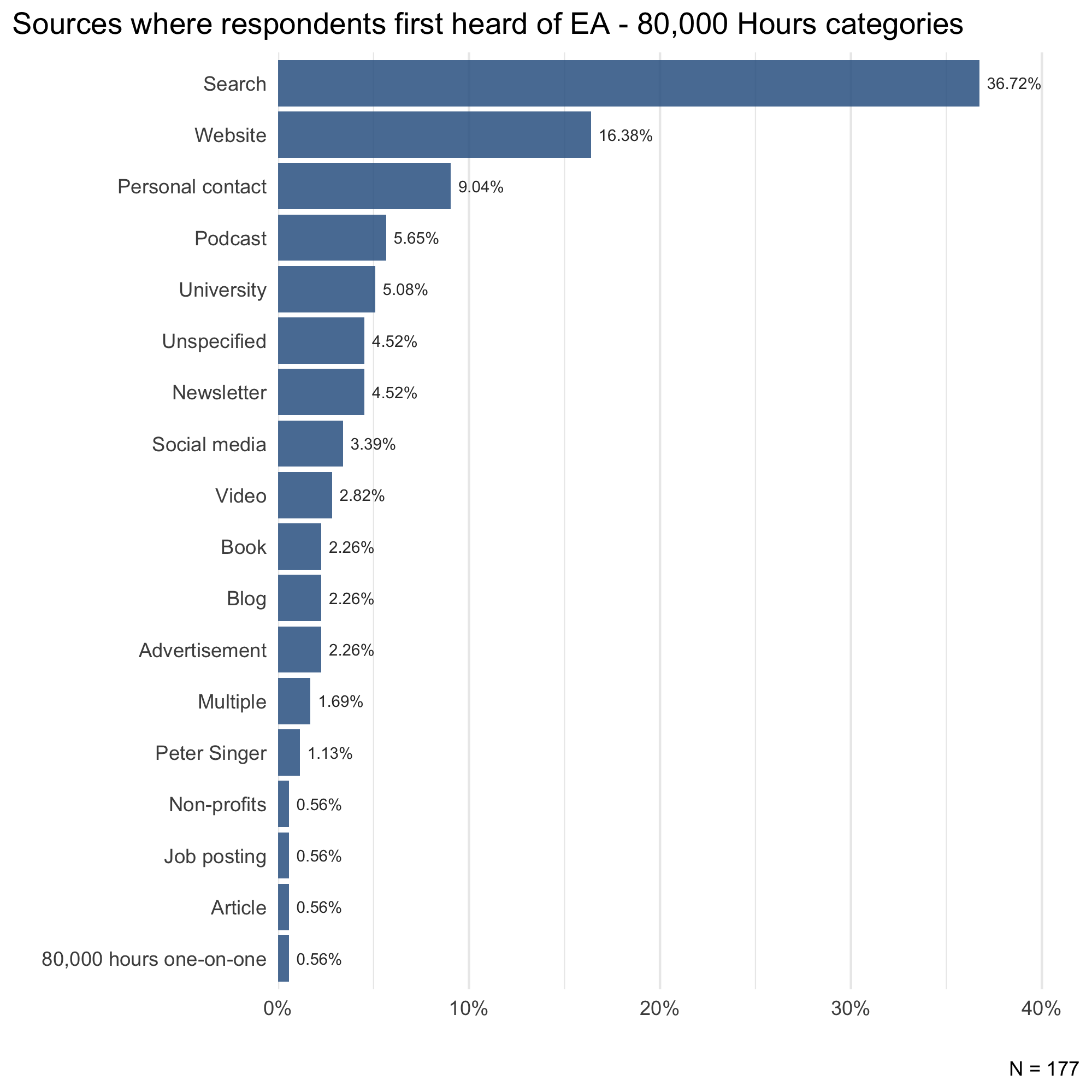
Books, articles, and blogs
A book was cited as the most common source of encountering EA when considering the category of books, articles, and blogs.
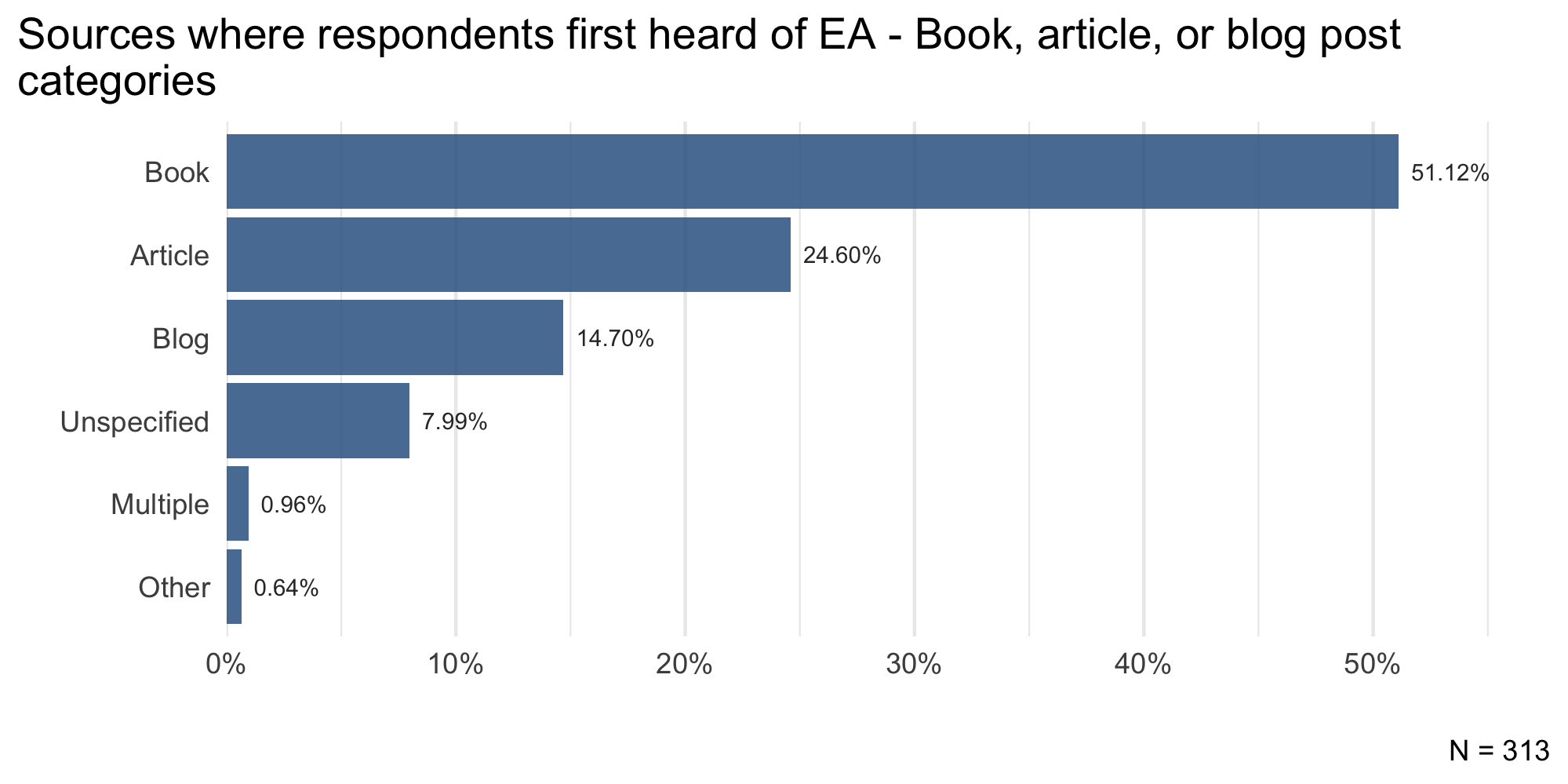
Books
Books by Peter Singer were by far the most frequently cited books, followed by Doing Good Better by William MacAskill. After these categories, Harry Potter and the Methods of Rationality was the most commonly mentioned book.
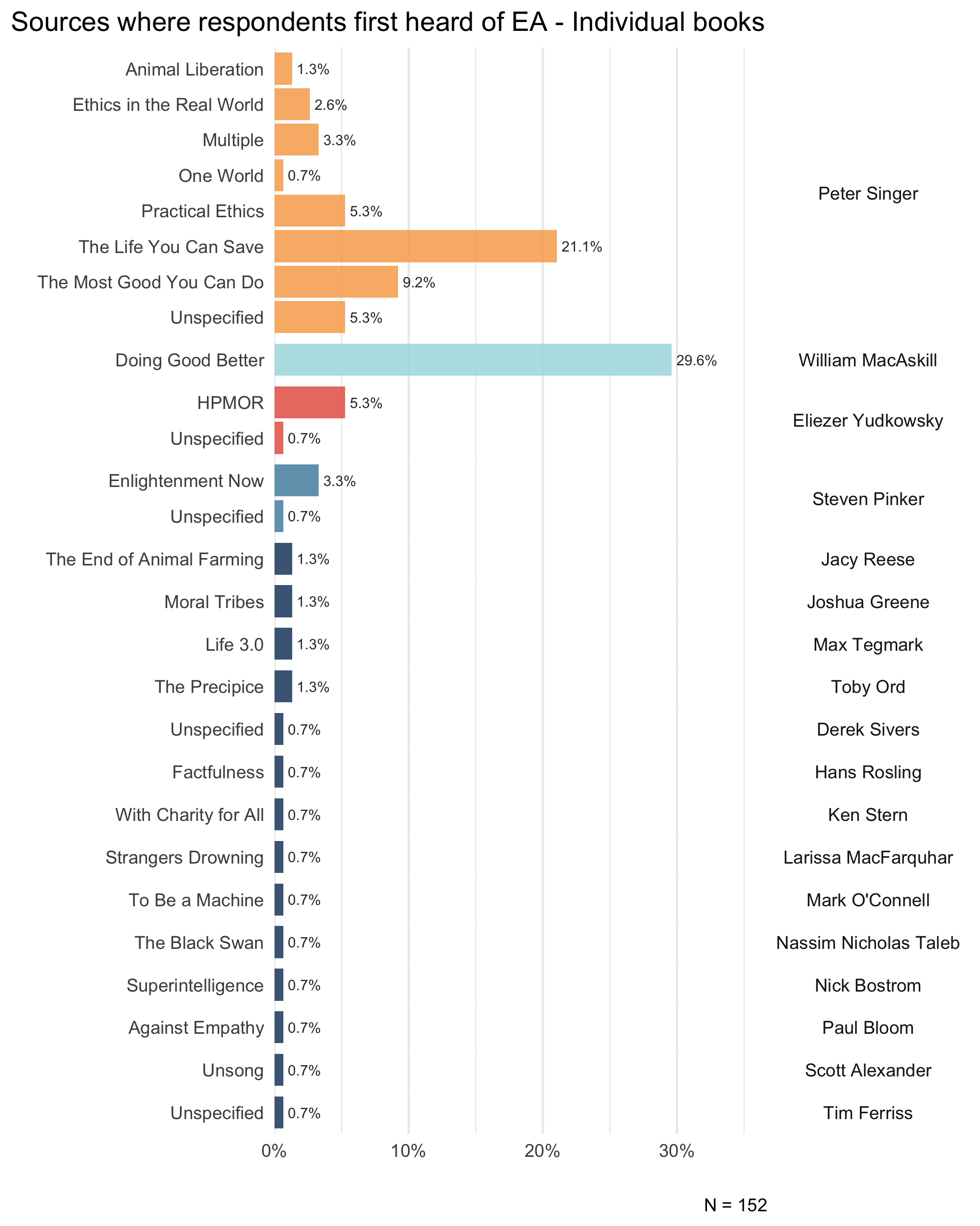
Articles
The most mentioned article was “Famine, Affluence, and Morality” by Peter Singer (n = 13). This was followed by articles from various news outlets including The New York Times, BBC, The Guardian, and The Atlantic.
Blogs
Thirty-four respondents mentioned a blog as the source where they first encountered EA, with Ozy Brennan’s Thing of Things, Kelsey Piper’s The Unit of Caring, and Tim Urban’s Wait, But Why? in the top three. Note that the Slate Star Codex / Astral Codex Ten blog was also listed as a category separate from the ‘Books, articles and blogs’ category and alone accounted for over 1/3rd as many people first hearing about EA as the whole ‘Books, articles and blogs’ category.
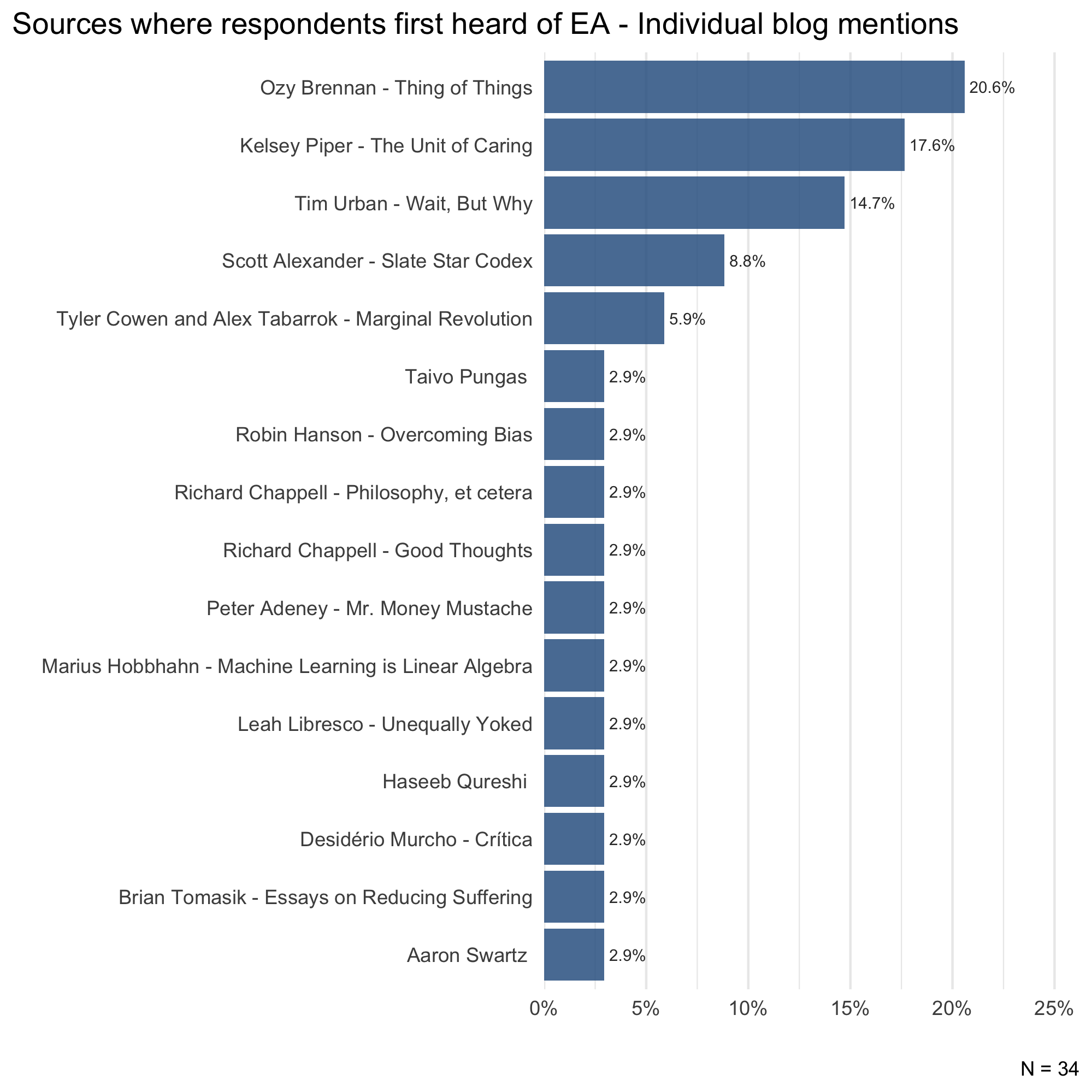
What factors are important for getting involved?
We asked about what factors “were important for [them] getting involved in EA,” allowing respondents to select multiple options. On average respondents selected around three options (median 3, mean 3.7).
Multiple factors were selected relatively frequently, with 80,000 Hours as the most commonly selected factor (58.0%), followed by personal contact with EAs (44.0%), and EA groups (36.8%).
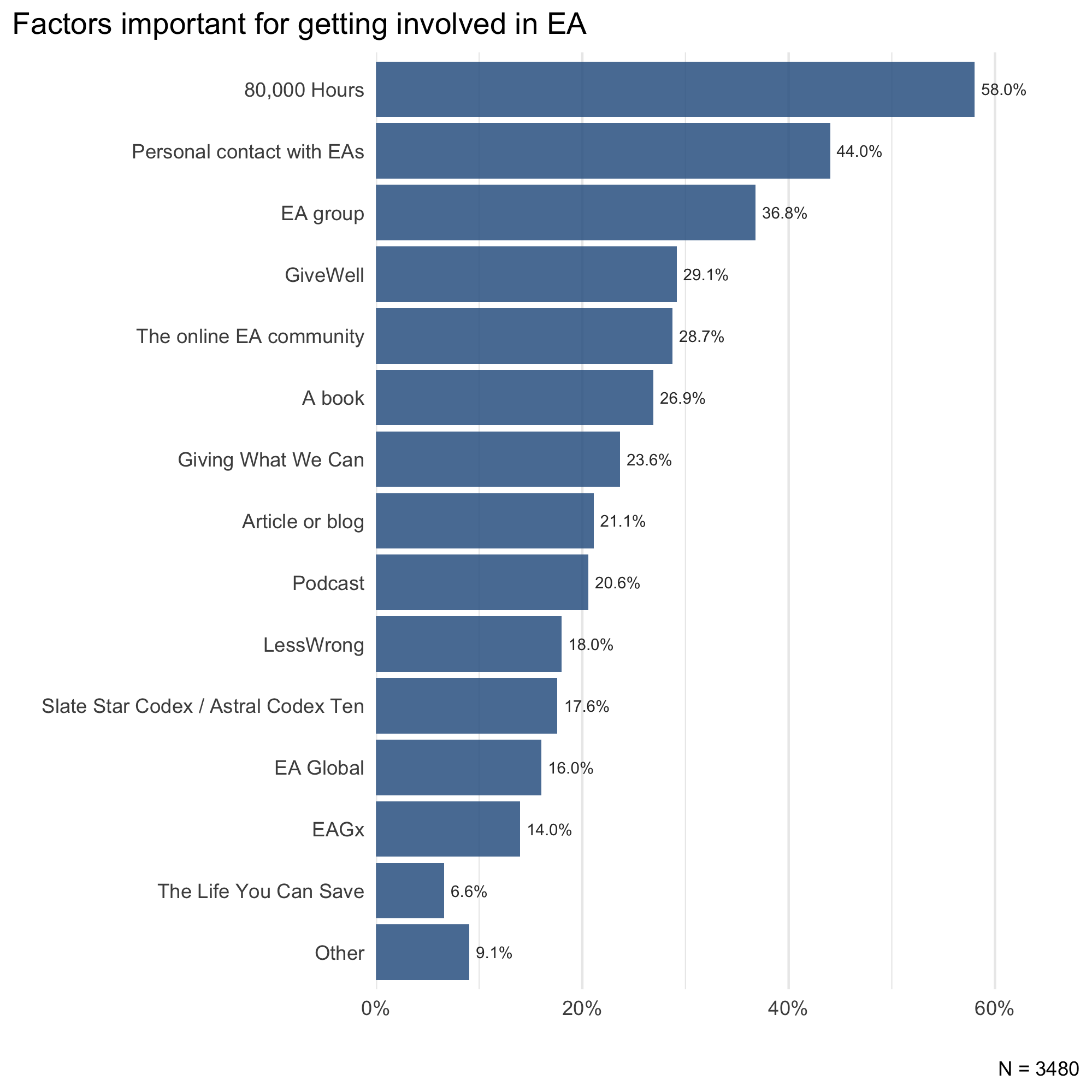
Changes in What is Important for Getting Involved in EA by EA Survey Year
We observe that several factors have been increasingly selected as being important for getting involved. These include 80,000 Hours, EA groups, and EAGx. There were also a few factors that saw a noticeable increase between 2020 and 2022, such as EA Global, personal contact with EAs, and the online EA community.
The importance of LessWrong seems to have diminished over the years.
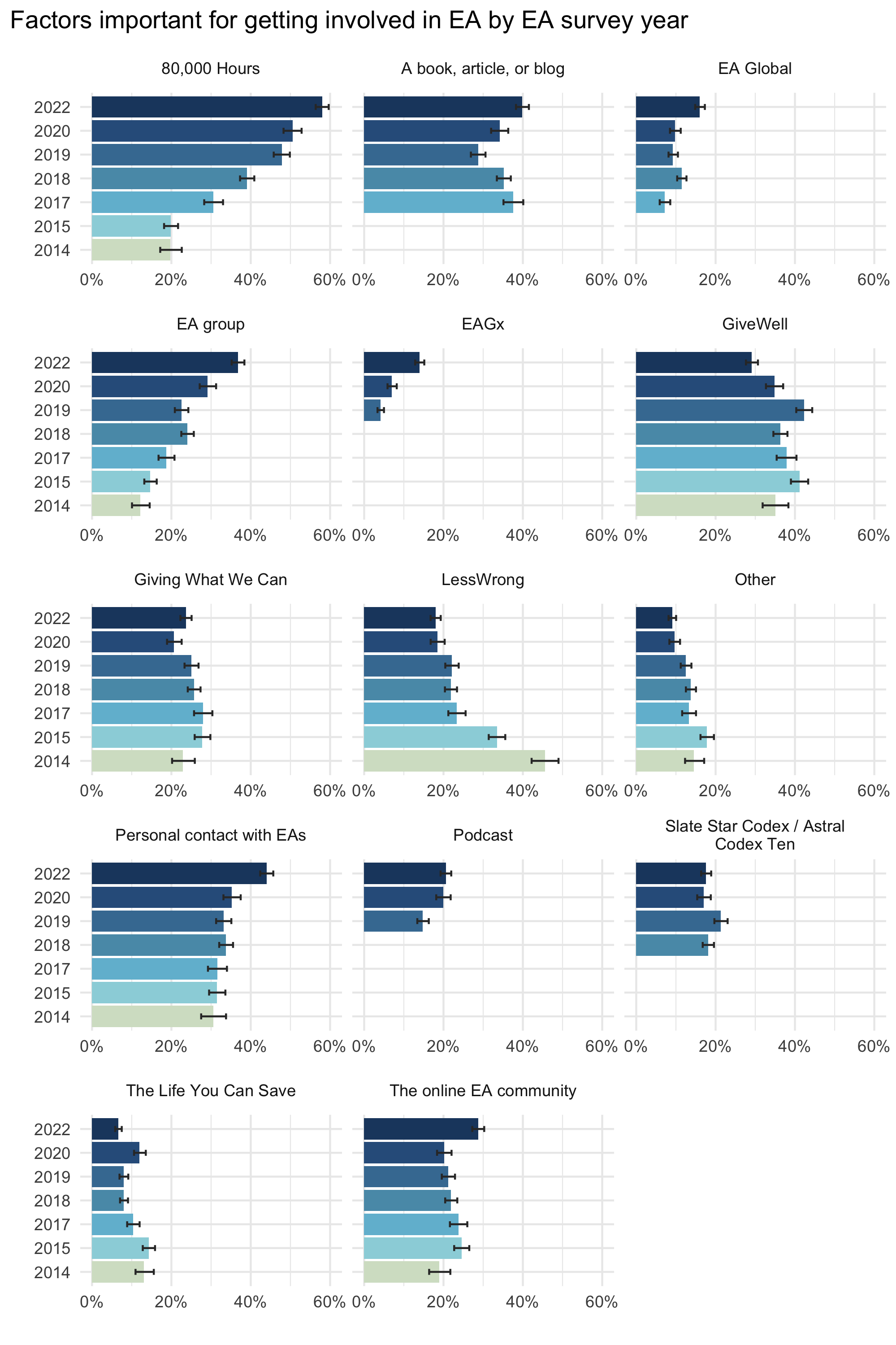
Changes in What is Important for Getting Involved in EA by Cohort
Below we show the distribution of factors selected by the different cohorts. Because newer cohorts have encountered fewer factors, we calculated the percentage as the percentage of the total number of factors selected by each cohort, as opposed to the percentage of the number of respondents in each cohort (see the Appendix for a graph showing the percentages of this calculation).
Overall, we do not observe many differences between cohorts in which factors are selected. There are a few patterns, which we note below. First, 80,000 Hours is shown to be disproportionately important, relative to other factors, for EAs who have gotten involved since 2016. A similar pattern was observed in the last EA Survey.
There are several factors which appear to be less important for more recent cohorts compared to older cohorts. These include GiveWell, Giving What We Can, LessWrong, and Slate Star Codex / Astral Codex Ten.
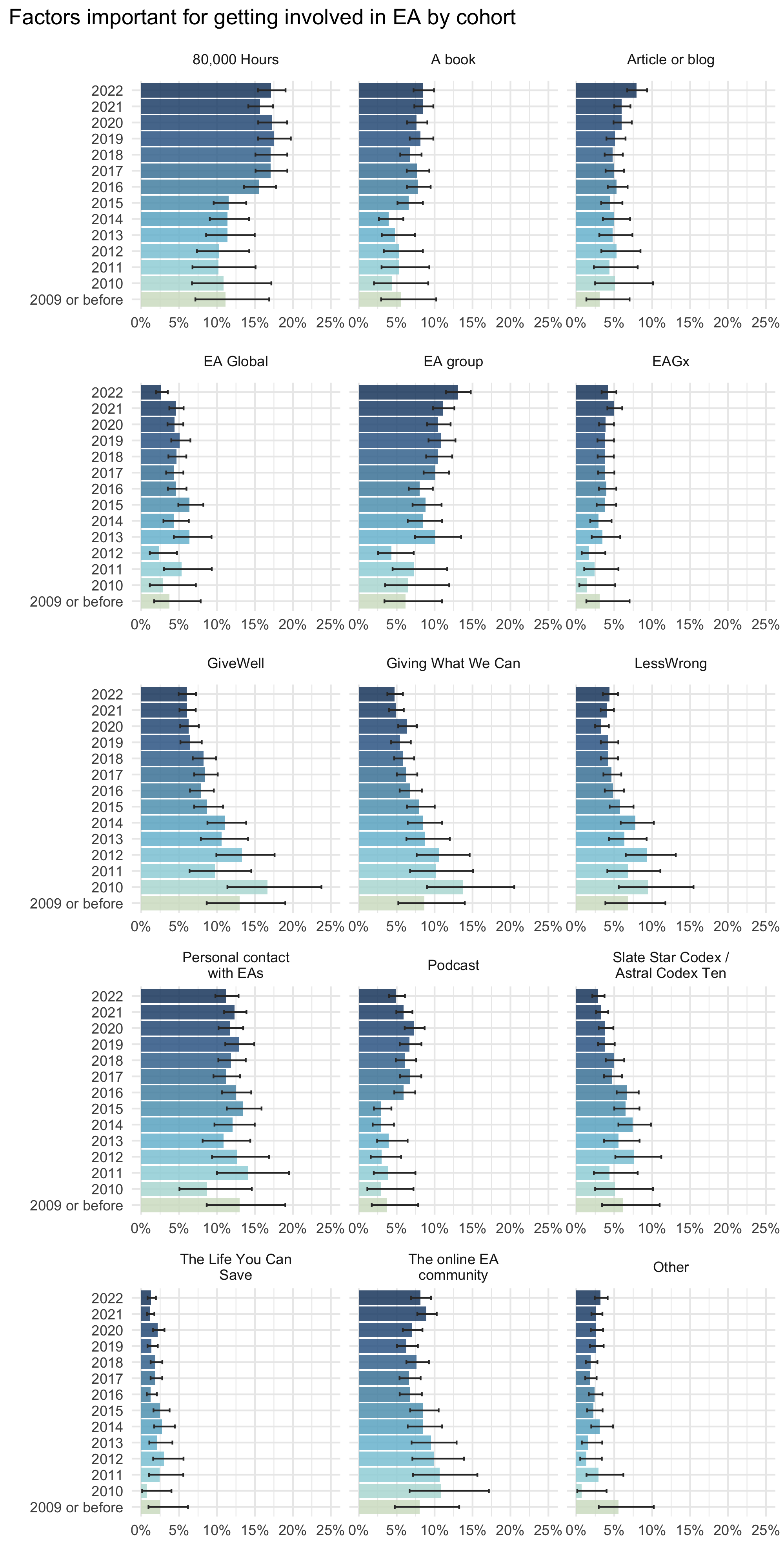
Differences Between Groups
First Hearing About EA
Engagement
Respondents low in engagement were more likely to have heard of EA via 80,000 Hours than respondents high in engagement, who were more likely to have heard of EA via a local or university EA group. Respondents low in engagement were also slightly more likely to have heard of EA via the Slate Star Codex / Astral Codex Ten blog and via podcasts. Interestingly, relatively more highly engaged respondents indicated that they first heard of EA via a TED talk. As we have discussed in previous reports, these differences are likely, in large part, explained by which sources have recruited more EAs more or less recently, since these newer EAs are less likely to be highly engaged.
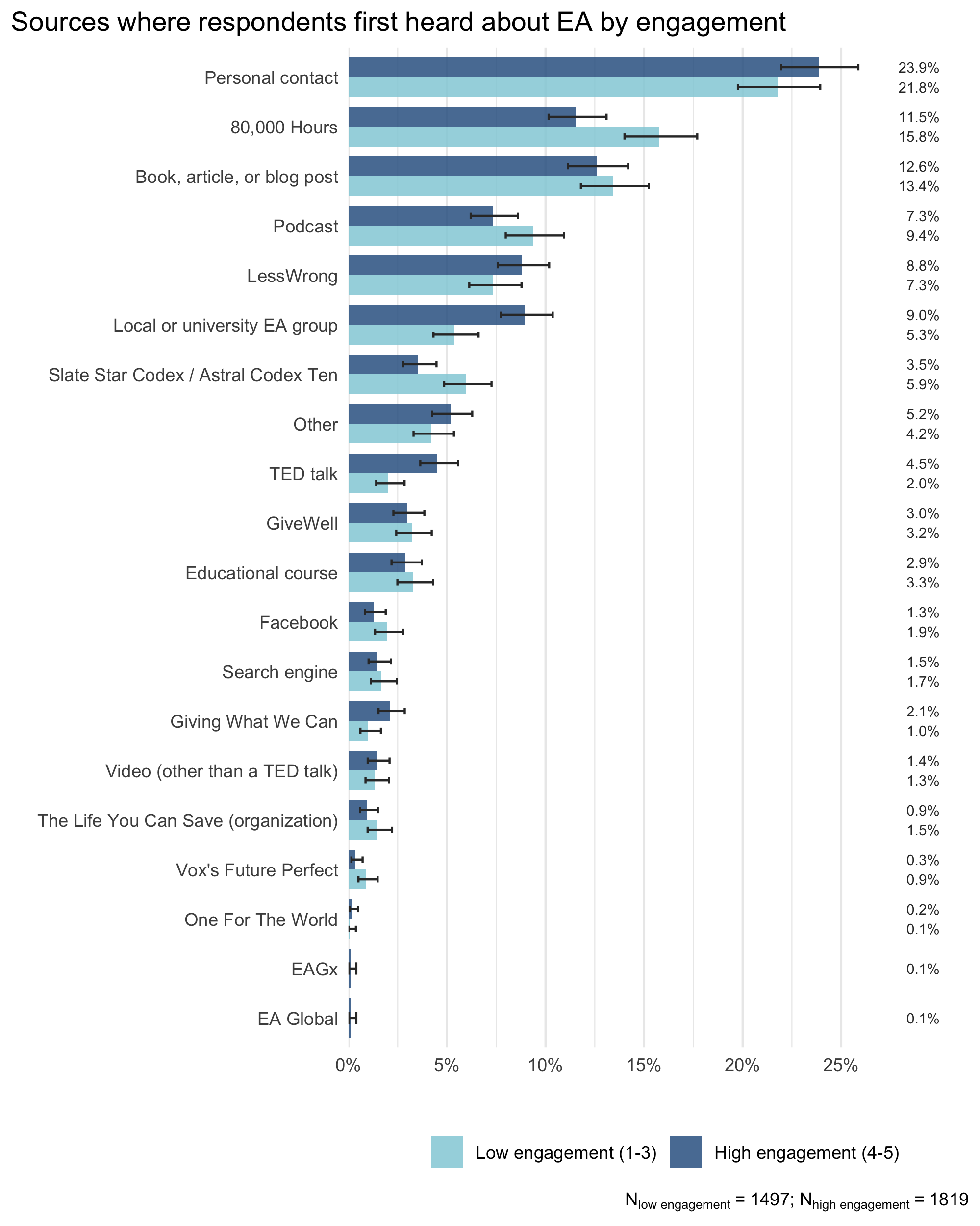
Below we show the distributions of all engagement levels by where respondents first heard about EA.
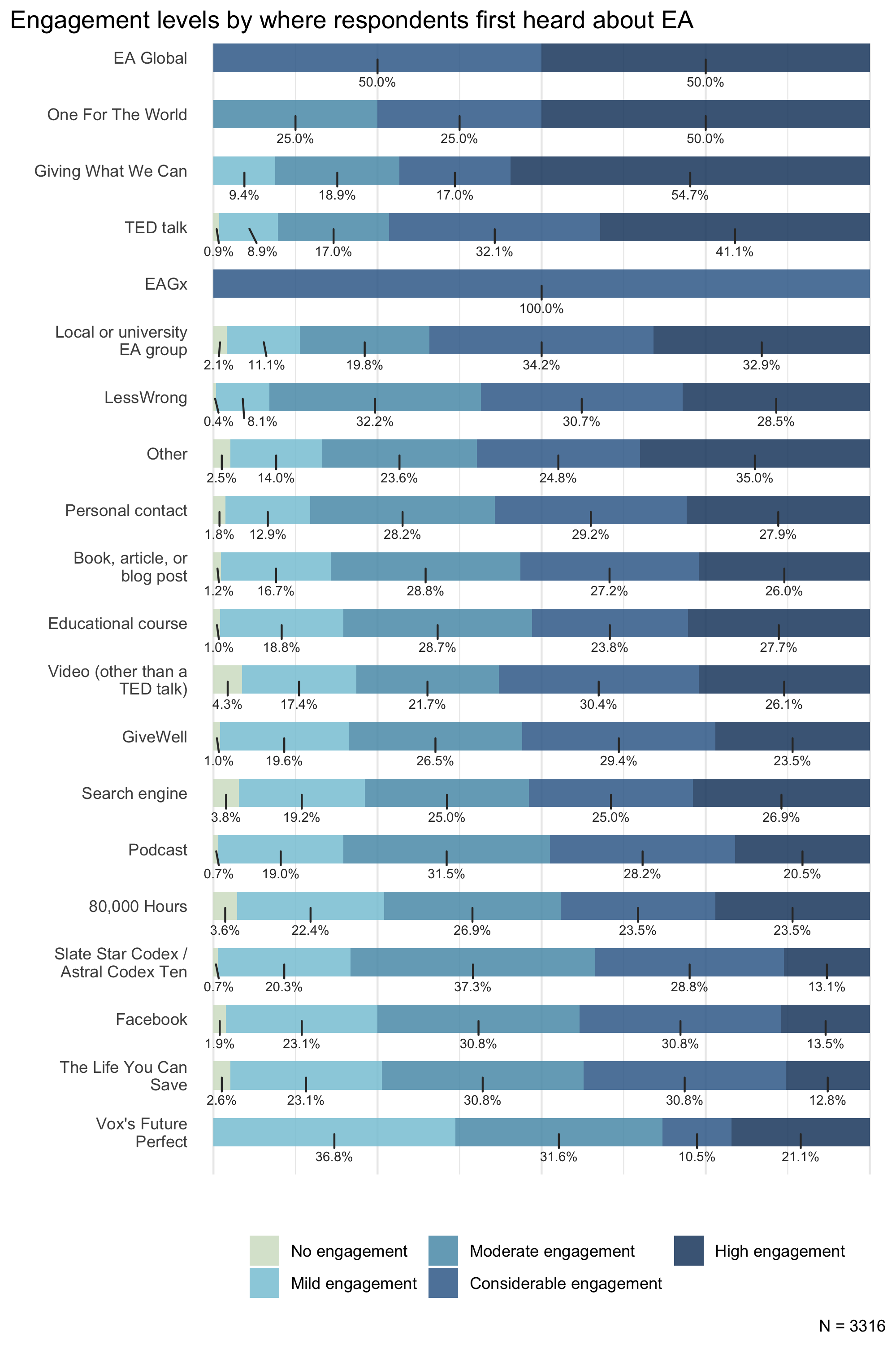
Gender
We found that respondents whose gender selection was woman, non-binary, or prefer to self-describe (grouped together as ‘Did not select “man”’), were much more likely to have first heard of EA via a personal contact. The same, but smaller, difference was also found for having heard of EA via a local or university EA group. Respondents who selected identifying as a man were more likely to have heard of EA via a podcast, LessWrong, a book, article, or blog post, and Slate Star Codex, although these differences were fairly small.
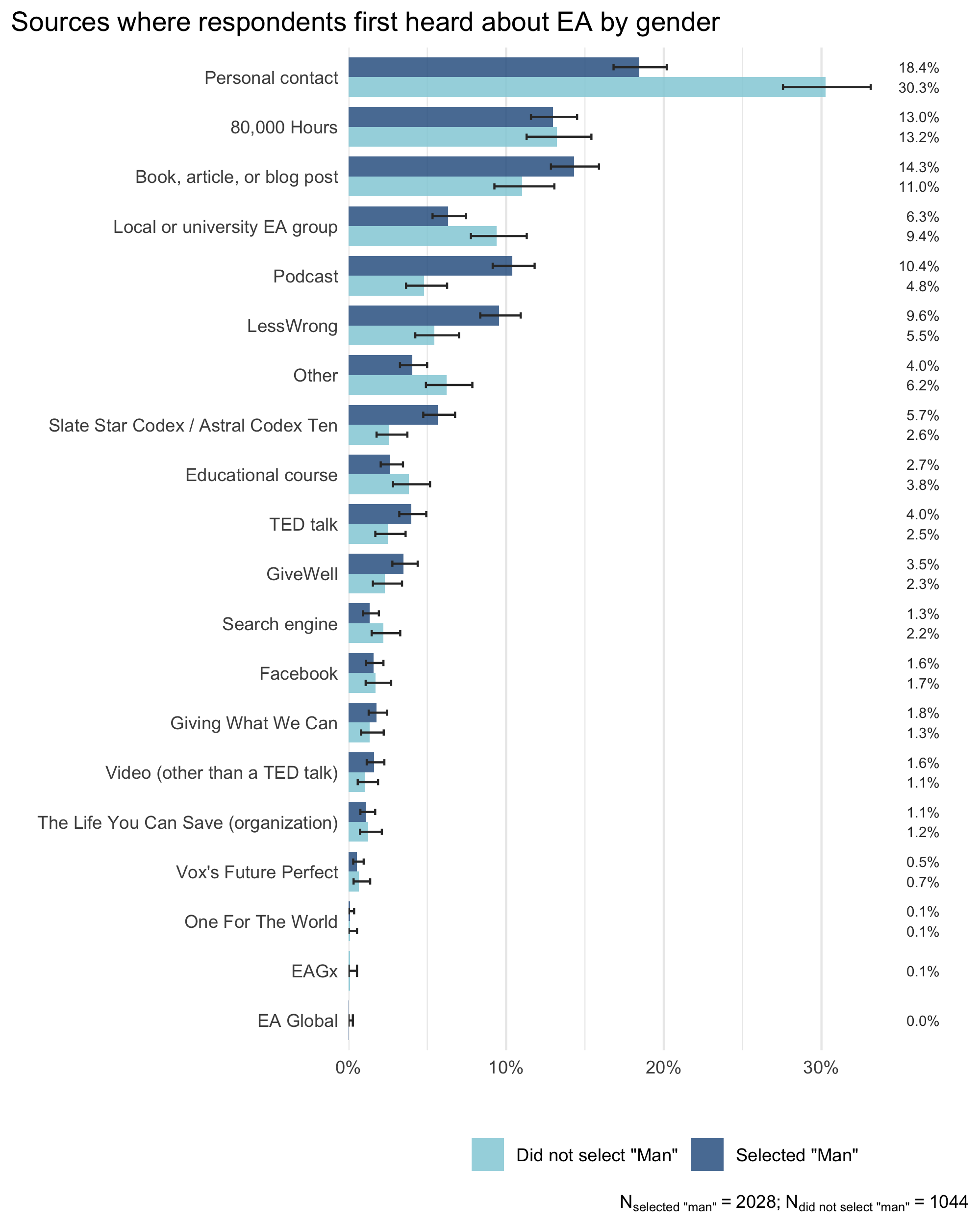
Racial identity
Respondents identifying as non-white were more likely to have encountered EA via 80,000 Hours compared to respondents identifying as white. Respondents identifying as white were slightly more likely to have encountered EA via a podcast and TED talk.
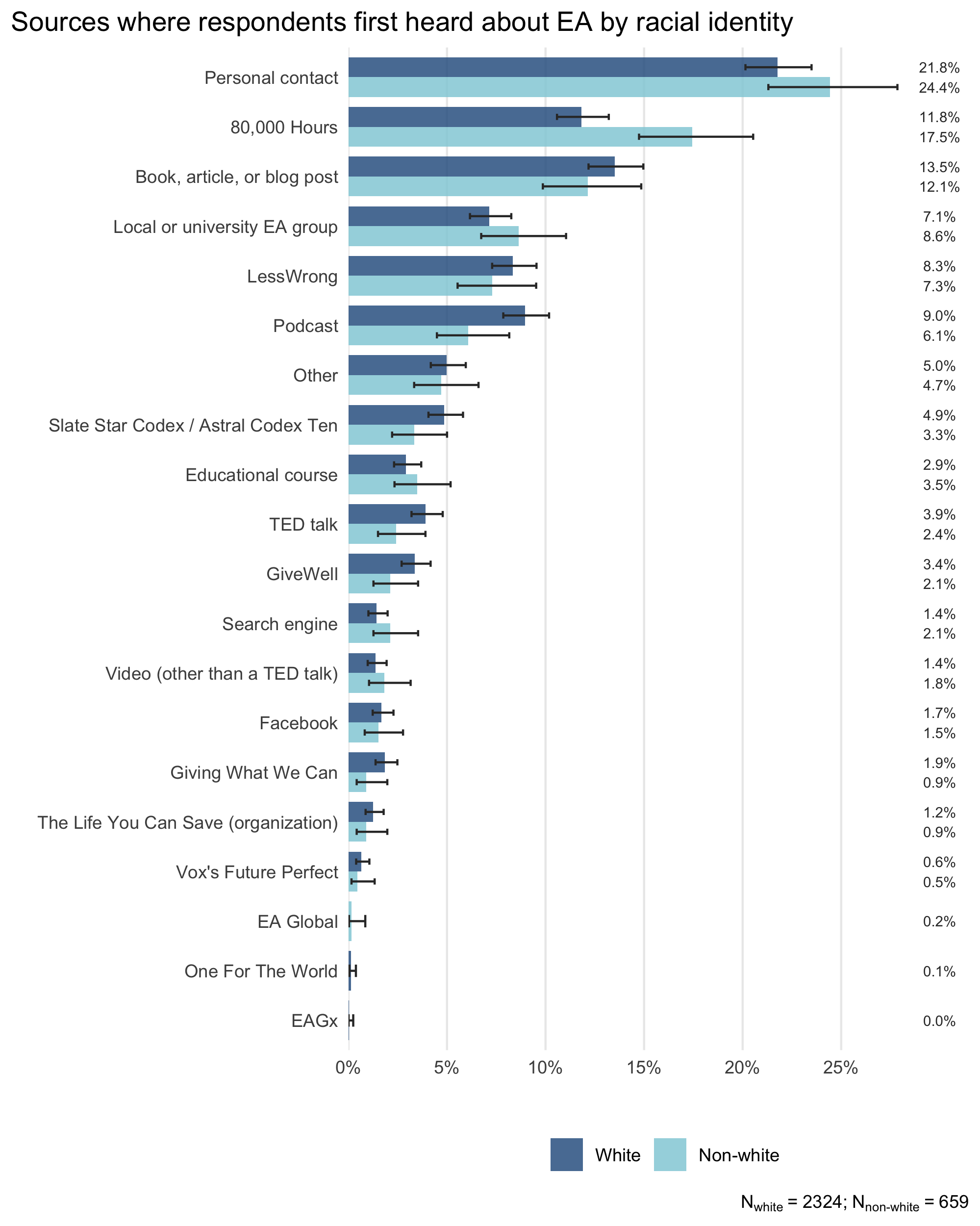
Getting Involved
Engagement
There were many differences between low/high engaged EAs—highly engaged EAs were more likely to select a factor as important for getting involved, with the exception of GiveWell, an article or blog, Slate Star Codex / Astral Codex Ten, and the Life You Can Save.
Personal contact with EAs, EA groups, the online EA community, EA Global, and EAGx stand out as being particularly important among highly engaged respondents.
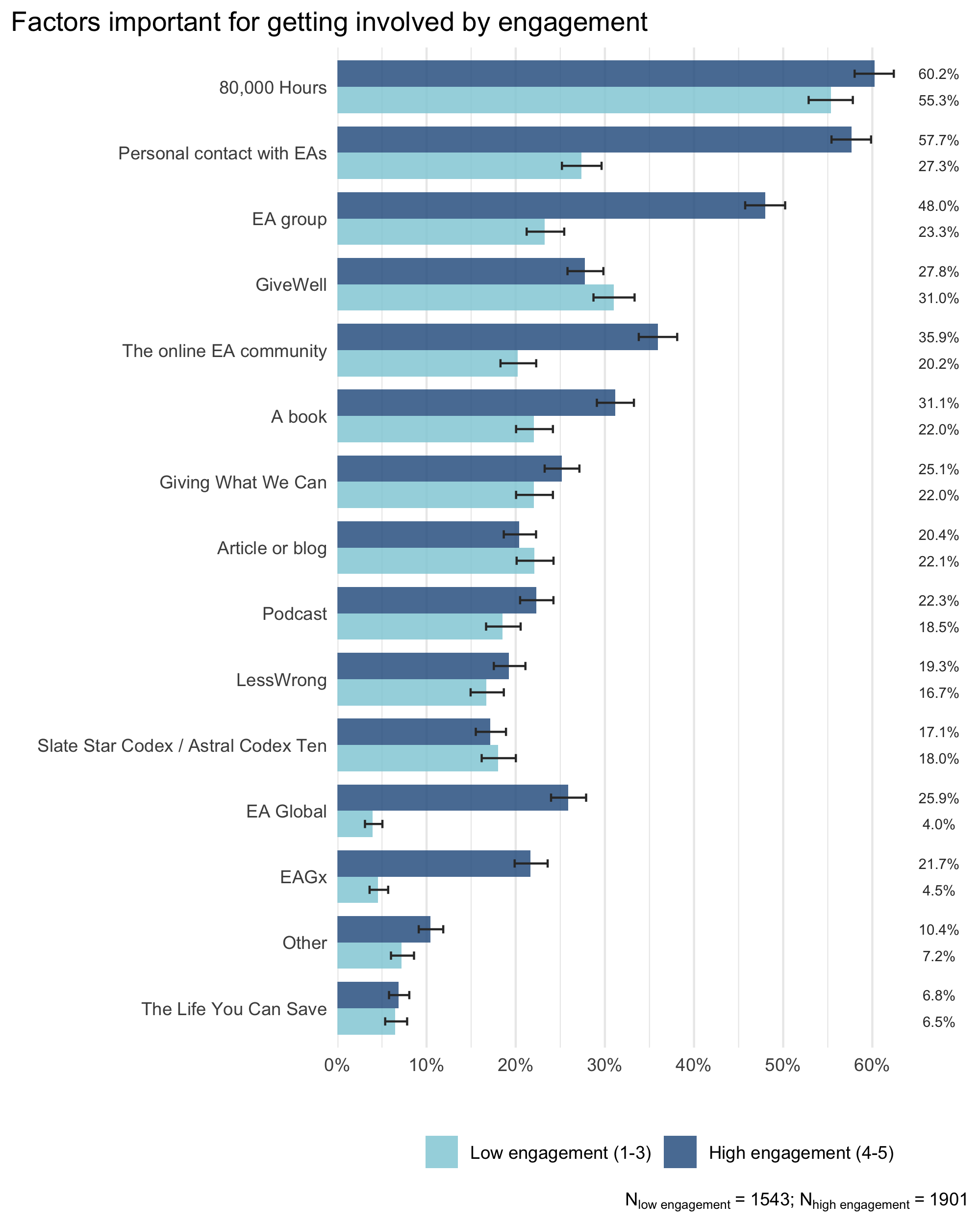
Gender
Respondents identifying as a man were more likely to select 80,000 Hours, the online EA community, GiveWell, Giving What We Can, a podcast, LessWrong, and Slate Star Codex / Astral Codex Ten as important for getting involved.
Respondents not identifying as a man were more likely to select personal contact with EAs, an EA group, and EAGx as important.
No differences were found between these two groups on book, article or blog, The Life You Can Save, EAG, and Other.
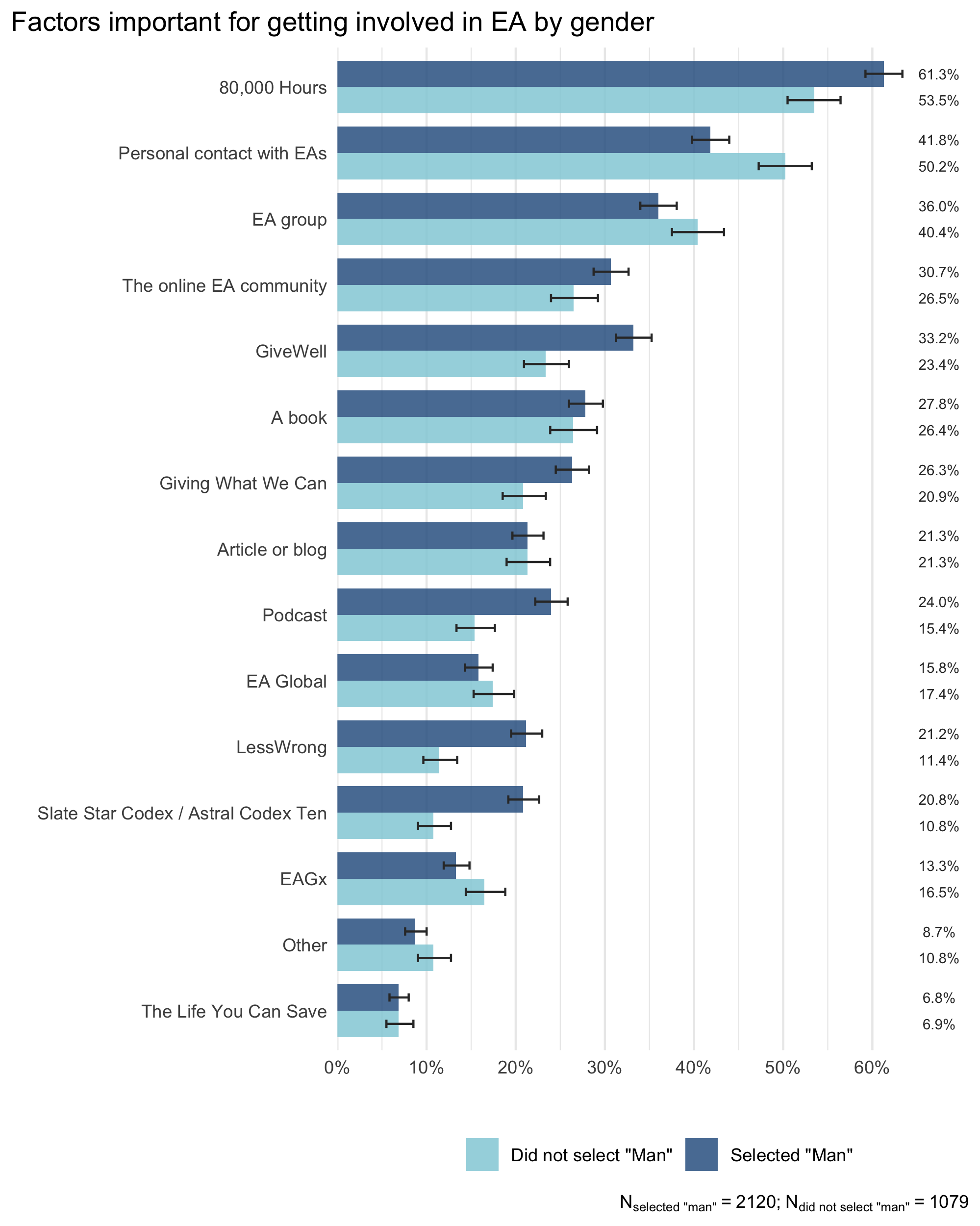
Racial identity
We found that respondents identifying as white were more likely to select GiveWell, a book, Giving What We Can, and a podcast as important for getting involved.
Respondents identifying as non-white were more likely to select an EA group, EAGx, and EA Global as important. Notably we found the same pattern for respondents not identifying as a man, indicating a similarity between these two demographic groups.
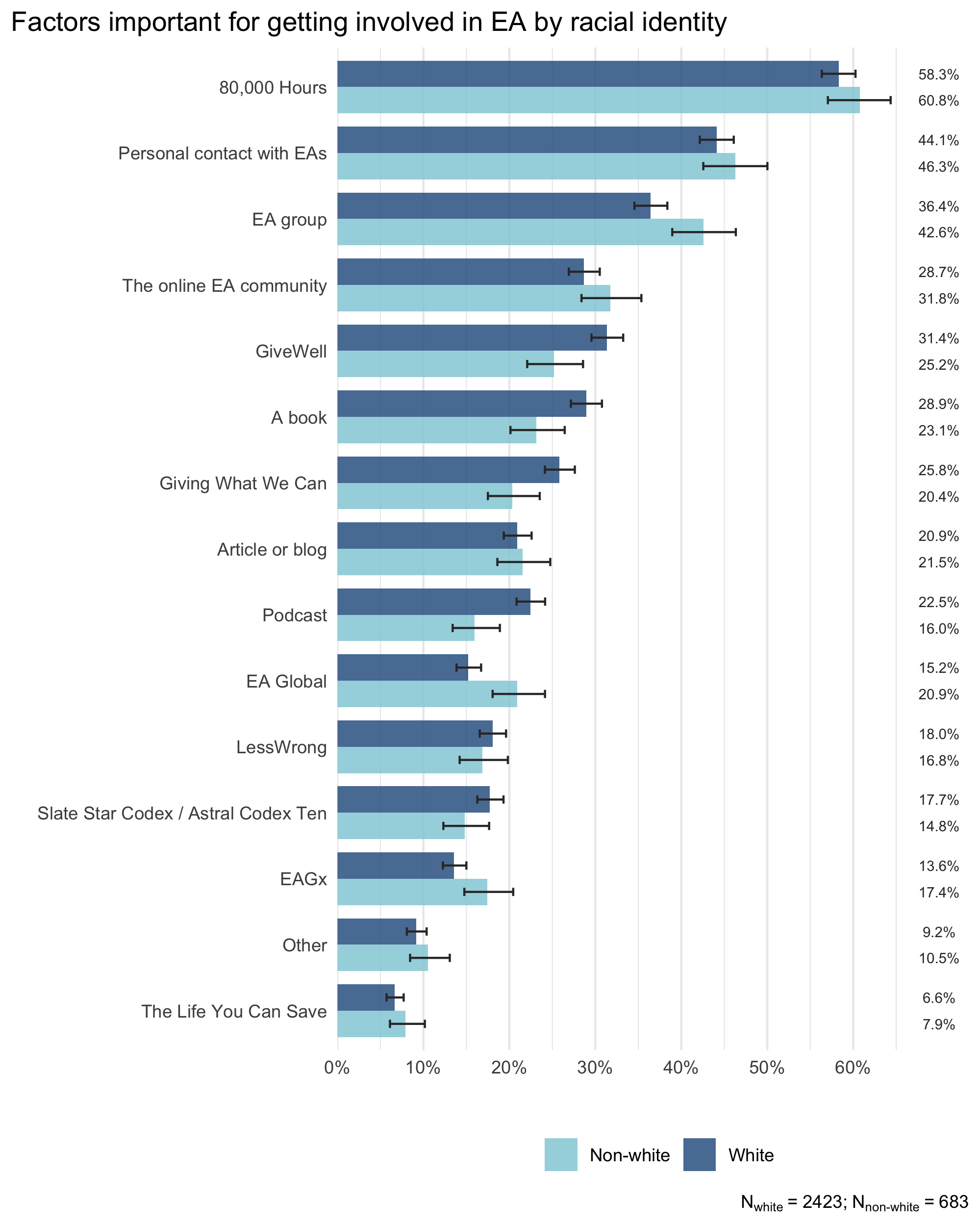
Appendix
Factors important for getting involved by cohort
The graph below shows the percentage of respondents from each cohort who selected each factor, as opposed to showing the percentage of votes from the total number of votes within a cohort.
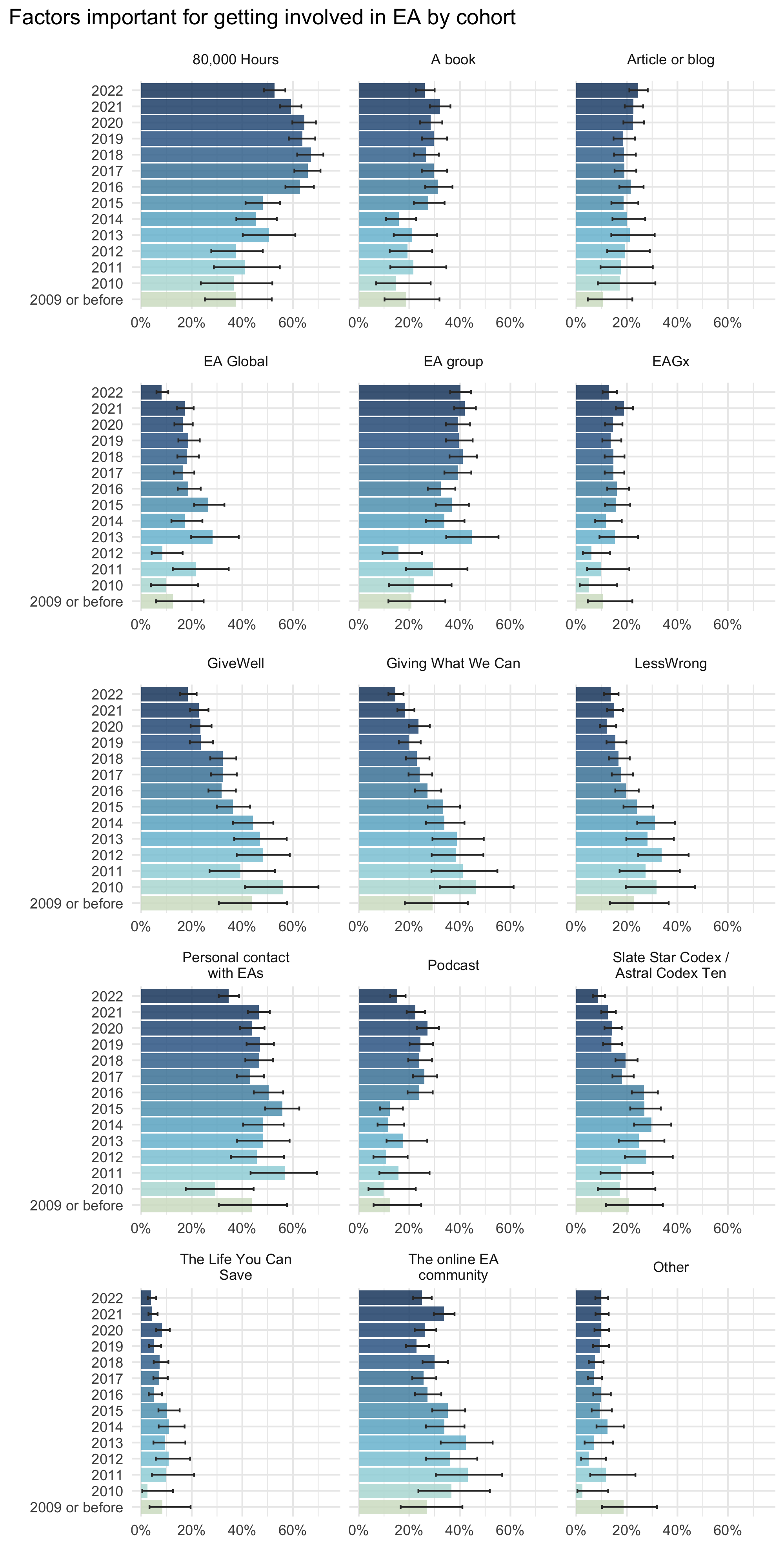
Acknowledgments
This research is a project of Rethink Priorities. This post was written by Willem Sleegers and David Moss. We would also like to thank Peter Wildeford, Adam Papineau, Kieran Greig, Nikolai Vetr, and Erich Grunewald for comments.
If you like our work, please consider subscribing to our newsletter. You can see more of our work here.
- ^
People could select from a total of 20 options where they first heard about EA, including “Other.” A total of 283 respondents selected this option. Of these, 116 fitted an existing category and so were recategorized.
- ^
- ^
As always, it is important to remember that differences between cohorts could reflect differential attrition between different groups, rather than differences between EAs who got involved at different times.
- ^
Though it is also possible that some of the encounters through a search or through social media or a video are due to ads, e.g., Google ads.

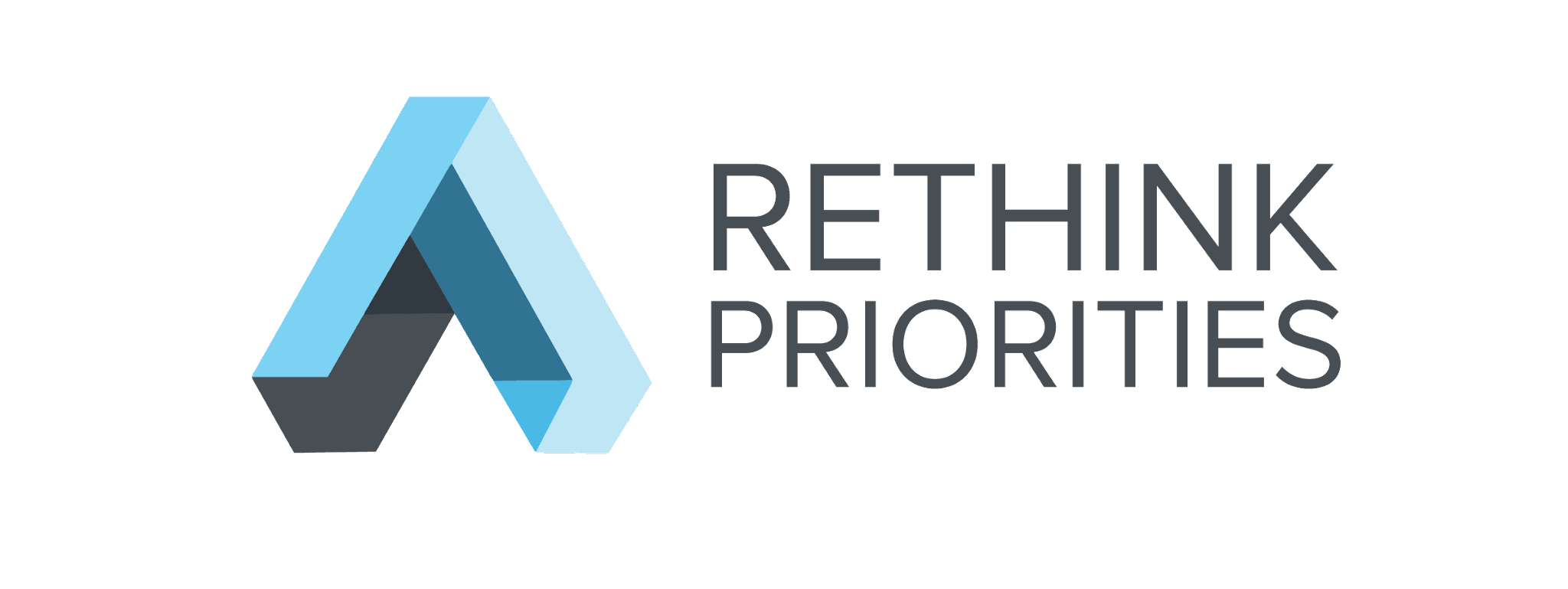
Okay, so GWWC, LW, and GiveWell, what are we going to do to reverse the trend?
Seriously, should we be thinking of this as "these sites are actually getting less effective at recruiting EAs" or as "there are so many more recruitment pipelines now that it makes sense that each one would drop in relative importance" or as "any site will naturally do better in its early years as it picks the low-hanging fruit in converting its target population, then do worse later"?
GWWC's membership has steadily grown in the recent years, so it's not that GWWC isn't getting more people to give significantly and effectively! I think this highlights broader questions about what the focus of the current effective altruism community is, and what it should be.
GWWC team members have advocated for a "big tent" effective altruism where everyone who wants to do good effectively should feel that they can be a part of the community - but anecdotally we hear sometimes that people who are primarily interested in giving don't feel like the broader effective altruism community is the right place for them. (So this might be why there is a decreasing trend seen in the survey)
I'd like to see that trend reverse, and GWWC continues to push for an inclusive EA community, where a spectrum of involvement is respected and celebrated but we can't do it all ourselves! We're only one part of the community, and I think it would take an increased focus on the "big tent" approach from other key organisations to help this be corrected.
Thanks for the comment. I would add that we also found signs related to this in our recent survey on responses to the FTX crisis (e.g. that there was divergence between more longtermist and more neartermist members of the community, with the latter less satisfied and more concerned in various ways).
We'll be discussing these issues in more detail in our forthcoming post about community satisfaction, retention and mental health.
I think the elephant in the room might be OpenPhil spending at least $211m on "Effective Altruism Community Growth (Longtermism)", including 80k spending $2.6m in marketing in 2022.[1]
As those efforts get results I expect the % of EA growth from those sources to increase.
I also expect EA™ spaces where these surveys are advertised to over-represent "longermism"/"x-risk reduction" (in part because of donor preferences, and in part because they are more useful for some EAs), so that would impact the % of people coming to these spaces from things like GiveWell.
High uncertainty, but for LW and ACX users I'm not sure about the view that they have of CEA spaces. My impression is that for LW users it might plausibly be negative, so they might spend relatively less time in the places where this survey was advertised (which are mostly CEA-run / OpenPhil Longtermist Community Growth - funded).
I think that's negligible compared to the $200m effort in longtermism community growth from OpenPhil, and again I'm really uncertain about this, but there might be a lot of EAs (e.g. GiveWell donors) that might have become relatively less likely to respond to these surveys
Some of it in late 2022, but I think the main point still stands
I think this is one case where it's useful to also look at the absolute numbers from each source across years rather than the percentages. (Usually the absolute totals risk being very misleading/confusing, because the total numbers of respondents from different surveys varies a lot, e.g. 2020 was a nadir, with just over 2000 respondents, whereas in 2022 we recruited over 3500).
The raw numbers show similar numbers from GiveWell across years, whereas GWWC's raw totals do seem lower than their peak in earlier years. So it doesn't seem to simply be the case that they've been outpaced by faster growth from 80K or others.
Also worth noting that the 2020 podcast jump was significantly contributed to from the Sam Harris episode taking the GWWC Company Pledge (which was also a significant shift in his advocacy moving forward). This involved a lot of work behind the scenes from our side but would be attributed here as "finding EA (and GWWC)" from the podcast.
Also in ~2017 GWWC chapters were converted to EA groups so that also explains some of the difference (GWWC chapters used to be a way that people found out about EA in-person which was largely supplanted by EA groups so that now people find out about GWWC in-person via EA groups).
Both really important points, Luke! I think the shift from GWWC Chapters to EA groups is not obvious to many people in the community and represents some of the wider shift we've seen!
Or, for GiveWell and to a lesser extent GWWC, "changes in EA's focus over the years have made it less likely that the population interested in GiveWell would be engaged enough in the EA meta to see and complete the survey?"
This is great, thank you for all of your work on it! In future iterations, do you think you might look at which podcasts in particular are people's entry point? We've seen an influx of people entering EA NYC via Sam Harris over the past several months and I'm curious what the podcast breakdown looks like and what lessons we can take from it.
Hi Rockwell, thanks for the question.
![]()
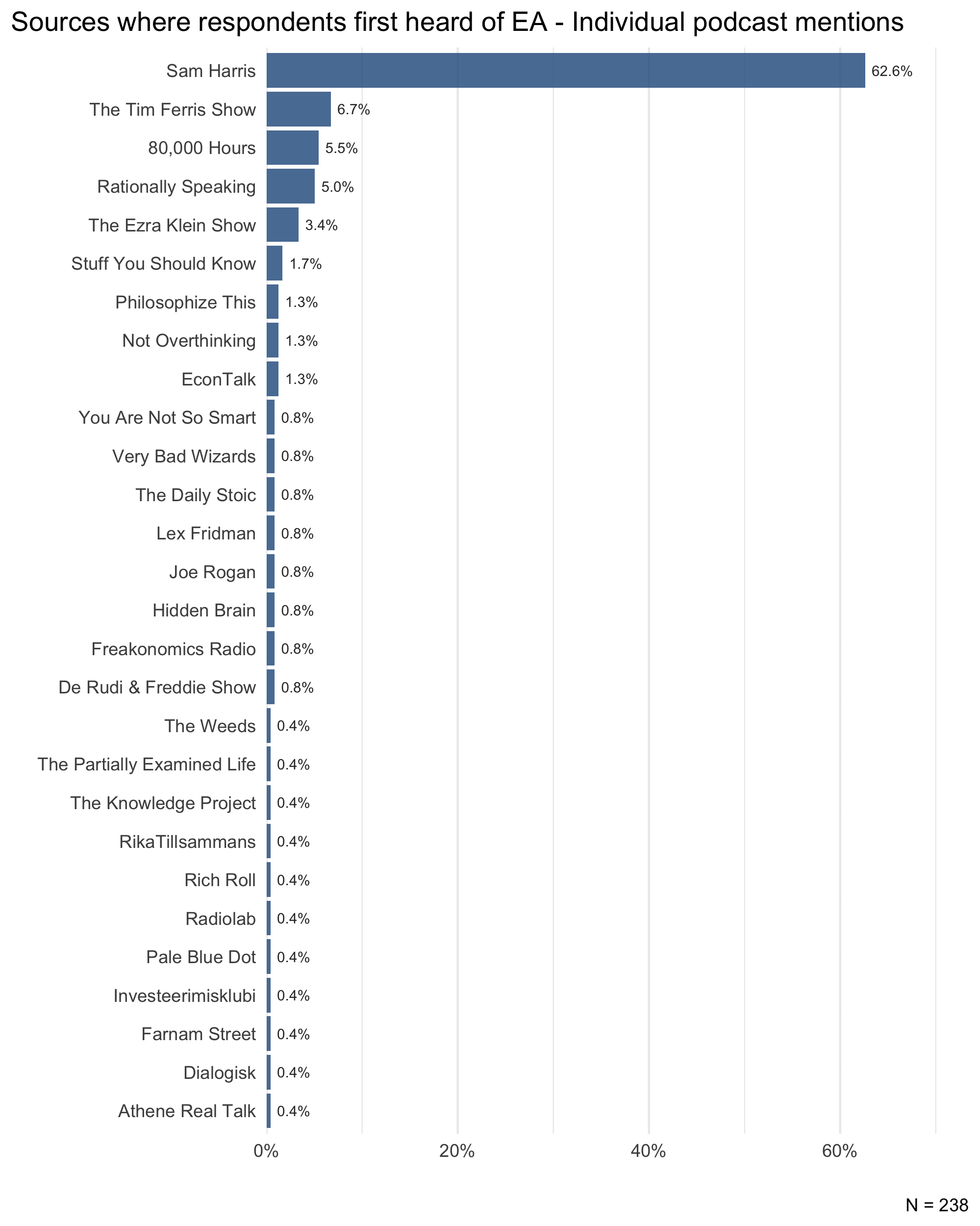
![]()
In response to your comment I went over the descriptions from respondents who said they first heard of EA via a podcast and coded, where possible, the name of the podcast or podcast host. I also included the numbers from respondents who first heard of EA via 80,000 Hours and who specifically mentioned the 80,000 Hours podcast. The results are in the graph below.
It shouldn't be too surprising to hear people who enter EA mention Sam Harris because his podcast is by far the most popular podcast mentioned, at 62.6% of all podcasts.
Wow, thanks so much for looking into this! If you have the time, I'm also curious about the demographic breakdown of those who listed Sam Harris.
Sure!
Sam Harris' audience consists largely of respondents identifying as a man (n = 125, 86.8%). Respondents identifying as a woman made up the remaining numbers (n = 19, 13.2%), no respondents indicated being binary or preferred to self-describe.
Their average age is 30.69 (median of 28), with a minimum of 19 and maximum of 64, see below.
Regarding racial identity, a large majority reported identifying as White (n = 117, 86.0%).
Finally, there was a roughly even split between less engaged (in EA) respondents (n = 66, 45.5%) and more engaged respondents (n = 79, 54.5%).
If the definition of being more engaged includes going to EAG and being a member of a group, aren't some of these results a bit circular?
In addition to my other comment, I would add that there are two different things to distinguish:
Thanks for the comment.
I think the fact that the engagement scale makes reference to specific activities as examples is worth bearing in mind (we've discussed this before, going back to the 2019 post where we introduced the scale, and the 2020 post, and more recently in the comments on the Demographics post).
You're right that there could be an influence from 'the scale mentioning "attending an EA Global conference" as an example in one of the higher engagement categories' -> people who attend EAG being more likely to be select (and so be counted as) higher engagement -> higher engagement people being more likely to say EAG was important for them getting involved (because they are more likely to have attended EAG).
However, I think there a few reasons why the results are nevertheless not likely to be largely circular.
As another illustration, we can look at the association between engaging in different activities related to EA and reporting that EAG is important for getting involved in EA. This just asks whether people have completed each activity (0 = no, 1=yes), so there's no possible circularity in the wording.
As we can see, people who have engaged in each of the individual the activities are much more likely to report that EAG was important for them getting involved.
In addition, I created a simple 'engagement_score' based on the number of activities individuals had completed (0=1SD lower below the mean, 1=1SD above the mean'). We can see that the results for the engagement_score are almost identical to the results for high_engagement on the self-reported engagement scale (in black).
For more discussion of the associations between and validation of the engagement measures see our 2019 and 2020 reports.
What was the recruitment method for this study? Do you think that could be skewing the data in any way?
The most detailed discussion of this issue is in our bookdown from last year.
The survey is distributed with the help of a number of different EA orgs through a number of different channels (noted below). In this year's EA Survey, the EA Forum was the largest referrer, followed by 80,000 Hours, and then via a sharing link for respondents to share the survey with others. In previous years the EA Newsletter has been more dominant and my impression is that a big factor is simply the timing of when different sources are released (e.g. many respondents would either see the survey via the Forum or the Newsletter because they read both, and will simply take the survey via whichever they see first).
One of the most important factors (which is unrelated to the particular referrers above) is that the survey recruits relatively more highly engaged EAs than people who are less engaged. In particular, we recruit many more people who are moderately-highly engaged (levels 3-5), and very few with lower engagement (e.g. have read EA materials for a few hours). I think this makes perfect sense, since we would expect people who are more engaged with the community to be more likely to take the survey.[1] Given this, you would likely want to consult the analyses we provide on differences between low/high engagement respondents to get a sense of the differences. Unfortunately, there's no way to simply weight the results to get around this (as we could if we were doing a representative survey of the US public, for example), due to the simple fact that no-one knows what the real composition is of the full EA population including those with low engagement with EA.
The other area where recruitment methods are particularly significant is where the referrers to the survey are also categories of interest in the survey questions. For example, as we have discussed before, 80,000 Hours is a large referrer to the survey, which may influence responses to questions which mention 80K. In last year's post, we therefore conducted an additional analysis, where we found that removing 80K-referred people, lowered the proportion of people selecting 80,000 Hours, though still let them among the most important sources (moving them from 50.7% to 45% of respondents). As we noted in that post though, simply looking at the proportion who were not referred to the survey from 80K (or other factor) is likely to be a wild over-correction for the fact that people influenced by that factor were more likely to be referred to the survey from that factor.
If there's sufficient demand we could potentially produce another post looking at similar analyses, though my impression is that when we did so for last year's EAS there wasn't significant interest.
Though, as we note in the linked post, in practice, people may be primarily interested in the responses of those who are at least moderately engaged. Lower engagement would be someone who has e.g. "engaged with a few articles, videos, podcasts, discussions, events on effective altruism (e.g. reading Doing Good Better or spending ~5 hours on the website of 80,000 Hours)" but not necessarily engaged in any other way.
I was also wondering this - did 80k link to it in their newsletter (which has a big audience)?
Relatedly, I wonder if you can see differences in reported source by the place the survey respondent navigated to the survey from?
"Respondents low in engagement were also slightly more likely to have heard of EA via the Slate Star Codex / Astral Codex Ten blog and via podcasts. (...) As we have discussed in previous reports, these differences are likely, in large part, explained by which sources have recruited more EAs more or less recently, since these newer EAs are less likely to be highly engaged."
Is this statement not contradicted by the fact that SSC/ACX has decreased in importance with regards to attracting new members? i.e. shouldn't we expect these people to be more involved since they have been, on average, part of the movement for longer?
Although SSC/ACX has decreased in importance, I think it still recruited most of its respondents relatively late (partly due to starting later than other sources). e.g. SSC's peak was in 2017, but TED Talks recruited their most respondents in 2013 (mean years in EA for SSC = 3.8, mean years in EA for Ted Talk = 4.78). The case is more clear for podcasts (mean years in EA = 2.59).
That said, there was some evidence from last year's EAS of SSC respondents being lower engagement even in a model controlling for time in EA.
Is the survey data closed access? If so, would it be possible to request access? I have a few questions of my own I'd like to try answer
Unfortunately, we don't have consent from participants to share raw data (except with CEA / 80K, for particular purposes, if they opt for that). But if you let us know what questions you are interested in we can likely try to answer these. We have already conducted a large number of private analyses for EA orgs / community members.